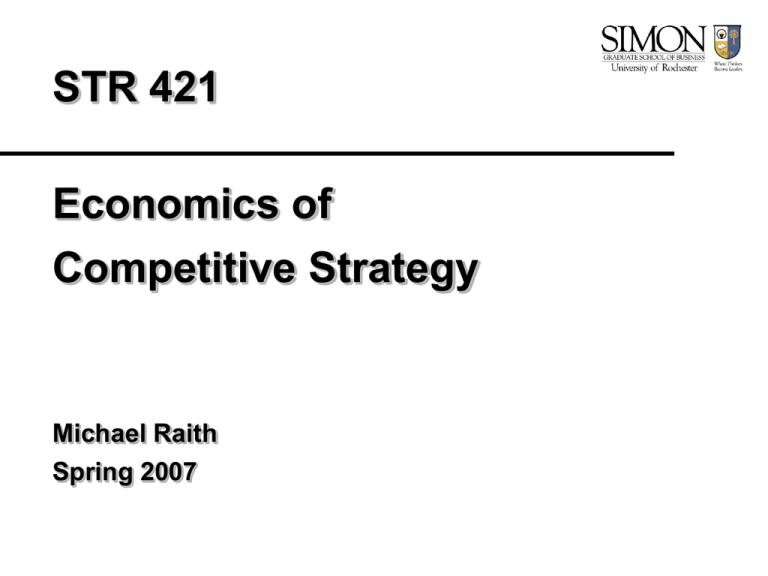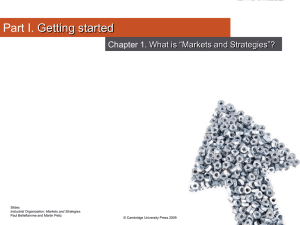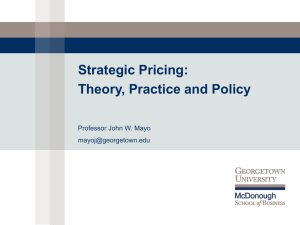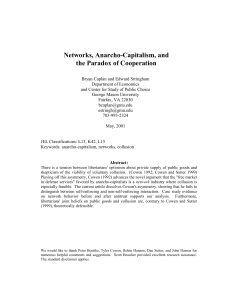Lecture: Dynamics of Pricing
advertisement

STR 421 Economics of Competitive Strategy Michael Raith Spring 2007 Course structure Part I: Obtaining and Sustaining a Competitive Advantage Part II: Strategic Interaction 4. Dynamics of price competition 5. Strategic commitments 6. Technological competition Today’s class 4. Dynamics of price competition 4.1 Shrimp game wrap-up 4.2 Logic of cooperative pricing 4.3 Factors hindering and facilitating coordination (next class) Shrimp game: example of a Cournot market Price (Bertrand) competition: firms set prices, quantities sold are functions of prices Quantity (Cournot) competition: firms choose how much to produce, market price is set so that demand = supply Applications: – (Oligopolistic) commodities markets: oil (OPEC), aluminum – Long-run competition: think of quantities as capacities Monopoly solution = perfect collusion Demand: P = 45 -.2 QTotal MR = 45 -.4 QTotal, set equal to MC=5 Optimal QTotal = 100, so QA = QB = QC = 33.33 – Price is 25 – Profit is 666.7 for each firm = 2000 for industry Independent decisions: look for Nash equilibrium First: find best response for each player – Find quantity that maximizes my profit given what I think my rivals are doing Demand: P = 45 -.2 (QA + QB + QC) Arnold’s MR, taking QB and QC as given: MR = 45 -.2 (QB + QC) - .4QA Set equal to MC = 5, solve for QA: QA = 100 – (QB + QC)/2 The more the others produce, the less you want to produce: QA 100 75 QA=100 - (QB + QC)/2 25 QB +QC 50 150 200 Static Nash equilibrium Nash equilibrium: each player chooses best response to other players’ quantities Solution: QA = QB = QC = 50 – Corresponding price is 15 – Profit is 500 for each firm = 1500 for industry, less than with perfect collusion At Nash equilibrium, no firm has incentive to change its quantity But with repeated interaction, strategic interaction gets very complicated: Example of prices in shrimp game: Prices over time 30 25 20 Price Series1 Series2 15 Series3 Series4 Series5 10 5 0 1 2 3 4 Round 5 6 7 Some worlds did better than static Nash equilibrium, others worse Failed attempts to cooperate: incentive to be mean greatest when others are nice: Arnold Beatrice Charlotte Quantity 33 33 66 Profit 449 449 898 Trying to beat others in industry? Arnold Beatrice Charlotte Quantity 50 50 65 Profit 350 350 455 Moral: competitive mindset can be very destructive Least profitable firm in nicest world almost always has higher profit than most profitable firm in meanest world Avoiding price wars more important than outperforming competitors With repeated interaction, competitors can and will react to your attempts to steal business from them How do firms manage to cooperate? Today’s class 4. Dynamics of price competition 4.1 Shrimp game wrap-up 4.2 Logic of cooperative pricing 4.3 Factors hindering and facilitating coordination Cooperation in the shrimp game Suppose: – Firms expect to play this game forever, choose quantities weekly – Future profits are discounted by 20% annually ≈ 0.35% weekly Possible strategy for the repeated game: – If no one has deviated so far, produce 33 and get profit of 667 – If someone deviates and it is observed by others, switch to static Nash equilibrium (Q=50) forever, and get profit of 500 Suppose deviations are observed with ¼ probability Key to coordination is a long horizon of interactions ahead Equilibrium? – Payoff from cooperating: $667/0.0035 = $190,571 – Payoff from cheating: 889 (this week) + 0.998 * (discount from next week) (3/4 * 667/0.0035 + (deviation is not detected) 1/4 * 500/0.0035) = 179,175 < 190,571 No incentive to deviate! (deviation is detected) In our game, last round mostly uncooperative In rounds right before last, when cooperation worked, you didn’t know that game would end very soon Airlines that are on the verge of bankruptcy cut prices. Why? Tit-for-tat pricing Problem with “trigger” strategy above: threat of price war forever is very costly if followed through Alternative: “tit-for-tat” pricing = Match price that rival charged in previous period Axelrod (1981): experimentally, best strategy to induce cooperation Why does it work? Axelrod argues: Tit for tat is – – – – nice: never the first to start price war provokable: immediately matches a price cut forgiving: return to cooperative pricing if rival does easy to understand (“We will match our competitors’ prices”) Problem (see BDSS): misperceptions can lead to large losses – Possible solution: “forgiving” TFT = Wait until it is clear that defection taking place An Example: Airlines in 1998 March Northwest begins sale on 14-day advance purchase fares. Others match April Continental twice tries to raise leisure fares by $20 per round-trip. Other carriers match, but Northwest blocks both attempts May Northwest initiates 25 % sale on 21 -day advance-purchase fares. Others match. Later, Continental tries 5% increase on non-sale leisure fares. United, American, Delta and USAir match, but not Northwest. Increase is rolled back July Continental raises leisure fares $20 round-trip; Northwest blocks August 11 Delta and American raise fares by 4%, Northwest blocks August 14 American raises fares by 4% in markets not served by Northwest; carriers other than Northwest match August 17 Delta rolls back the increases; other airlines follow August 18 Northwest raises fares by 4%. All other carriers match the increase August 19 Northwest rescinds fare hike; US Airways and TWA match same day August 20 American, Delta, Continental match reversal; other carriers follow August 21 Northwest hikes fares by 4%, other carriers match Remark: Collusion and product differentiation are conceptually different Both lead to P > MC, lower internal rivalry, but: Product differentiation: At Nash equilibrium, cutting price not profitable even if rivals don’t respond Collusion: At cooperative price, cutting price not profitable because others are expected to retaliate – Cutting price is profitable in short run, i.e. before rivals can respond Antitrust restrictions Goal of antitrust laws is to promote efficiency Price-fixing agreements are per se illegal in U.S. – Recent international cases: Lysine cartel, vitamin cartel (late 90s), Sotheby’s and Christie’s (2001), Samsung in DRAMs (2005), L’Oreal, Chanel and 11 others in perfumes Parallel behavior in oligopolies not sufficient for antitrust violation; evidence of explicit agreement is required – Tacit collusion is currently not considered illegal in U.S. – E.g. Jewel’s and Dominick’s high milk prices in Chicago in late 90s: lack of evidence of conspiracy Today’s class 4. Dynamics of price competition 4.1 Shrimp game wrap-up 4.2 Logic of cooperative pricing 4.3 Factors hindering or facilitating coordination What determines ability to coordinate prices? 1. How easy is it for firms to tacitly agree on prices? 2. How effectively can deviations from an agreement be deterred? Need, for each firm, Profit under continued cooperation > Gain from deviating today + Probability of detection * Profit in a price war Effectiveness of retaliation 1. Can firms agree on a price? Finding a (tacit) agreement more difficult – the more firms there are Main reason why we care about concentration in 5 forces: collusion in aluminum, infant formula industries? – the more products there are, and the more heterogeneous the products – If there are cost asymmetries So what can firms do about it? Price leadership: if one firm is accepted by all as price leader, then it’s easier for all to coordinate prices Pricing rules to price large number of products – E.g. per-pound price rule for electrical equipment used by GE and Westinghouse in 1960s Information exchange, e.g. through trade association – about costs and demand – about which products are substitutes 2. Are there strong incentives to deviate? Gain from deviating is larger…. – the more firms there are – if orders are lumpy Commercial aircraft: Boeing vs. Airbus Industries with large business customers: e.g. CCS – if firms have excess capacity How can firms reduce the incentive to cut price? Advance announcement of price raises: if rivals don’t match, just rescind Exclusive territories for retailers Most-favored customer clauses – “If I sell to any other buyer at a lower price, I will also charge you the lower price (or pay you a rebate)” – Reduces the own temptation to cut price! Meet-the-competition clauses – “If any other seller offers you a better price, I will match it” – Makes it unprofitable for rivals to cut price 3. How effective is retaliation against deviating firms? Factors making retaliation more difficult – Lack of price transparency Retail gasoline, vs. corporate discounts in express mail industry – Demand fluctuations: were your sales low because of low demand or because someone stole your customers? – Product differentiation between firms Multi-market contact actually facilitates collusion, since cutting price in one market may trigger price war in all markets – Argument against merger of Union Pacific and Southern Pacific Railroads in mid-90s: multi-market contact with large rival How can firms make retaliation more effective? Sometimes excess capacity can help: punishing deviations requires some unused capacity – Saudi-Arabia’s capacity to flood market as way to discipline OPEC members Increase market transparency – Through information exchange – By standardizing products – Through pricing formulas The “topsy-turvy principle” of collusion “Factors/practices that lead to intense competition if firms don’t cooperate often actually facilitate coordination.” Examples: – High market transparency – Low degree of product differentiation Antitrust restrictions II Warning: many/most of the practices mentioned raise suspicions with antitrust authorities Many practices facilitate collusion, but also increase market efficiency among non-colluding firms – e.g. information exchange In evaluating facilitating practices, courts weigh proand anti-competitive effects










